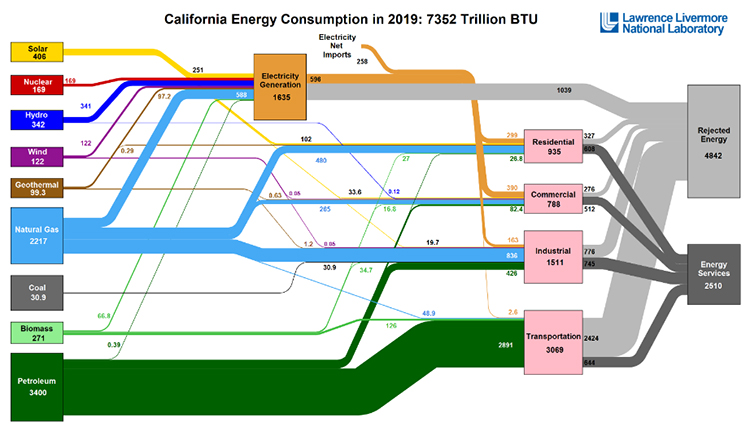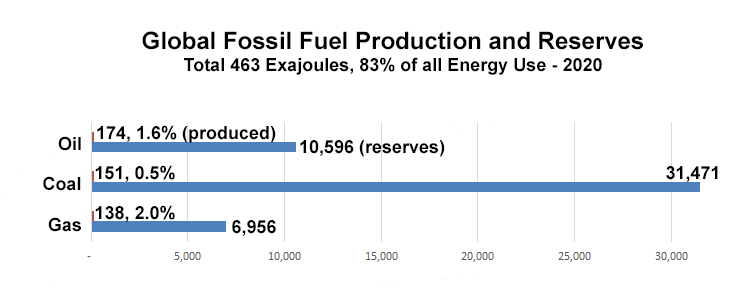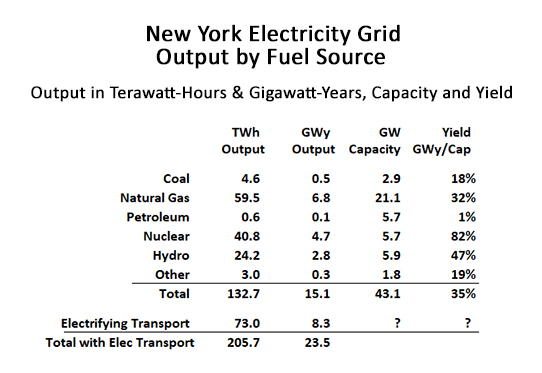If energy were abundant, clean, and sustainable, nearly every other daunting challenge facing humanity would be much easier to solve. Insufficient water? No problem. Pump more water around via inter-basin transfers and build more desalination plants. Can’t convert the transportation sector to all-electric vehicles? You can if energy is abundant. Generate all the electricity you need.
Energy solves almost every other resource-related challenge facing humanity. The more energy the better. As with water, energy abundance brings with it not only more practical options in almost every economic sector, and at a lower price, but it brings resilience as well.
On the other hand, pushing all excess out of the system via conservation mandates that amount to increasingly severe rationing leaves the system—and everything that depends on it—vulnerable to catastrophe under what might otherwise be a minor disruption.
The strategic goal of California’s energy planners is for the state to become “carbon neutral” as soon as possible. They view this both as an existential necessity and an achievable utopian dream. To accomplish this, California’s determination to be the first developed economy in the world to go fully electric is well established. Governor Gavin Newsom has decreed via executive order that new passenger car and truck sales have to be all-electric by 2035. In this he has the enthusiastic support of the state legislature. At the same time, the legislature is making it nearly impossible to install gas appliances in new homes. Expect that effort to only intensify in the coming years.
No gasoline allowed. No natural gas allowed. With those constraints, how will California ever achieve energy abundance? Gasoline, used almost exclusively as a transportation fuel, was responsible for 22 percent of the totalenergy consumed by Californians in 2019. In that same year, natural gas, which provided fuel for 43 percent of California’s total electricity generation, supplied 33 percent of the total energy consumed by Californians. Overall, natural gas and gasoline, the forbidden duo, provide over half of the energy on which Californians currently rely.
To create energy abundance without natural gas or gasoline, production of every other fuel Californians use would have to double. But what are these fuels? Are they acceptable? Not really. Additional fossil fuel sources include jet fuel at 8 percent, with other petroleum and distillate fuel oil adding another 12 percent. Despite all the work of recent decades, fossil fuel is still powering well over 80 percent of California’s economy.
The challenge doesn’t end there. Also out of favor is nuclear power, despite providing another two percent to the total energy Californians consume, and hydroelectric power, which adds another four percent. The favored few—biomass, solar, geothermal and wind—altogether account for only five percent of California’s total energy production. As for the rest, fully nine percent of California’s energy comes in the form of electricity imported from other states.
Understanding California’s Energy Landscape
These facts represent a reality that ought to have California’s legislators scratching their heads, instead of plunging headlong into additional renewables mandates and conservation schemes.
The underlying strategy is absolutely clear, but rarely expressed openly: Make energy cost so much that bleeding edge technologies can be mandated and the financing to pay for them will be covered by the consumer. And if the consumer can’t afford it, special government programs will subsidize those lower income households. Middle class Californians thus get a double hit—once as ratepayers for needlessly expensive energy, and again as taxpayers who have to pay to subsidize the less fortunate.
To get an idea of how complex the process is of getting from raw energy sources—fossil fuels, nuclear, hydro, wind and solar—to actual electrons running appliances or furnaces heating homes, Lawrence Livermore Labs and the U.S. Department of Energy have produced a flow chart that merits close study.

While there is a lot to digest in this energy flow chart, it offers valuable insight even without bombarding the observer with numbers. On the left, source fuel inputs are depicted, with the thickness of the lines (not the boxes) denoting the relative quantities of each fuel. Because electricity is not a source fuel, but has to be manufactured either using solar photons, or using a generator turned by wind, water, or fossil fuel, the box “Electricity Generation” shows up in the center left of the flow chart, in order to aggregate and redirect the quantities of source fuels that were converted into electricity. Further to the right, four boxes are used to aggregate and categorize what sectors make use of the various fuels including electricity, they are “Residential,” “Commercial,” “Industrial,” and “Transportation.”
It is immediately obvious that solar (yellow line) and wind energy (purple line) currently contribute an insignificant share of the total. Moreover, the method used by the study’s authors to estimate the amount of solar energy contributed to the grid greatly overstates the actual amount. Their error was to take the amount of actual solar electricity generated in 2018, 27.5 gigawatt-hours which converts to 93 TBTU (trillion British thermal units), and improperly inflate it.
Instead of recognizing that photovoltaic power generation is directly transmitted to the grid without loss, the amount of solar power shown in the yellow box on the upper right of the flow chart declares 382 TBTUs of energy flowed into the grid. The reason for this error, based on a flawed assumption that is explained in the footnotes on the flow chart (which I confirmed with an electricity grid expert at the California Department of Energy), was to assume that solar power is subject to the same conversion inefficiencies as burning fossil fuel.
The implications of this are interesting. Out of 7,404 TBTUs (adjusted for the error, 7,115 TBTUs) of raw source fuels consumed, only 93 TBTUs came from solar electricity; that’s 1.3 percent. That means Californians are a long way off from entering the solar electric age.
And yet the fact that solar electricity loses very little power when going from photovoltaic power to the grid to an EV battery to an engine is an encouraging fact. Electric transmission losses are about 10 percent, with perhaps another 10 percent lost in the onboard battery’s charge/discharge cycle and the electric motor’s conversion of electrons into traction. Compare photovoltaic electricity’s 80 percent efficiency getting from source to end-user to the average natural gas power plant, which can only achieve efficiencies of around 42 percent, or a gasoline powered automobile, which at best can achieve efficiencies of 35 percent.
The consequences of energy inefficiency—the amount of source fuel inputs that are lost to excess heat and friction—are seen on the far right of the flow chart, in the box “rejected energy,” which is twice as much as the box “energy services.” Of the estimated 7,404 TBTU of source fuel consumed by Californians in 2018, 4,907 TBTUs were wasted, and only half that much was enjoyed by Californians in the form of lighting, heating and air-conditioning, vehicular traction, and so on. By how much could Californians reduce the amount of fuel input, while keeping level or increasing their actual energy services, if they went totally electric?
Understanding Units of Energy Measurement
Anyone who has spent enough time reading the publications and reports that tout a clean energy future sees the marketing images: windmills presiding benignly over green pastures, solar panels glinting in the sunlight, row after row, set against a scenic horizon. But how many of California’s politicians, much less the marketing consultants and graphic artists who are selling this dream, have actually tried to parse gigawatt-years into quadrillion British thermal units? It’s not tough math. But it’s awfully tedious.
Policymakers, along with anyone with strong opinions on California’s energy policies, are encouraged to wade through these calculations, because they are crucial variables affecting the future of every Californian.
The first variable to understand is quadrillion BTUs. A BTU, or British thermal unit, is a measurement of energy typically used by economists. It is the amount of energy required to heat one pound of water by one degree Fahrenheit. Economists refer to the total energy consumption of entire states and nations in “Quad BTUs,” which refers to 1 quadrillion (1,000,000,000,000,000) BTUs. California, in 2019, consumed 7.8 Quad BTUs of energy (up five percent from 2018). Another common term is TBTU, which stands for “trillion British thermal units” (1,000 TBTUs equals 1 Quad BTU).
The second variable to understand is gigawatt-years, which is a measurement unit used to measure large amounts of electricity. A gigawatt-year is the amount of electric energy that would be produced by a one gigawatt power plant, operating continuously for one year. Economists, energy planners, and utility executives typically prefer to report terawatt-hours, probably since most consumers understand kilowatt-hours. But gigawatt-years is a more useful measurement of electric power.
Conceptually, these units of energy measurement are all convertible. Which is to say that one Quad BTU is equivalent to 33.4 gigawatt-years, and one gigawatt-year is equivalent to 8.8 terawatt-hours. For all units of energy, from horsepower to joules, to kilowatt-hours to British thermal units, or cubic feet of natural gas to barrels of oil, there are conversion constants that allow any unit of one form of energy to be expressed using units of another form of energy. Understanding how BTUs of natural gas or gasoline convert into electricity is necessary in order to estimate how much electricity is required to eliminate natural gas or gasoline.
The other essential concept is conversion efficiency. If every form of energy converted into another form of energy with 100 percent efficiency, the conversion constants would be all that was ever needed. But as previously noted, natural gas converts into electricity in a modern power plant at about 42 percent efficiency. Gasoline converts into traction in modern automobiles at around a 35 percent efficiency. And solar electricity can be delivered through the grid to an EV and converted into traction at around an 80 percent efficiency.
It is a fair bet that most of California’s state legislators and their staffs haven’t got the slightest idea how all of this works, which is why lobbyists for special interests and their useful cadres of fanatical activists (equally ignorant of energy dynamics) are so powerful.
Is a Solar Electric Economy Possible?
If you fly from California’s capital city, Sacramento, southeast into Los Angeles, you’ll see a growing number of sparkling greyish silver patches occupying sections of what previously was irrigated farmland in the San Joaquin Valley. These are photovoltaic arrays, ordered in row after row like crops, tracking the sun, each of them making their contribution to California’s electricity grid. And catching up fast are battery farms, many of them located on the sites of decommissioned natural gas power plants, designed to soak up and store the surplus electricity generated during the hours of peak sunlight, for discharge typically in the early evening when grid demand goes up as the sun goes down.
It would go well beyond the scope of this analysis to try to precisely estimate how many TBTUs of energy input would be required to create energy abundance in a purely electric economy. But it is a relevant question to ask, since that’s where current policies are taking Californians.
For a rough estimate, therefore, take the amount of actual “energy services” consumed by all four sectors of California’s economy—residential, commercial, industrial, and transportation—during 2017. Assume that in an all-electric economy, instead of the reported 2,497 TBTUs of useful output requiring three times that amount of fuel input, based on the relative inefficiency of fossil fuel conversion to the various energy services, assume that only 25 percent more is required. Convert that to an electrical unit of measurement and you’ve got 104 gigawatt-years. Round that up to 125 gigawatt-years to be absolutely certain to achieve energy abundance.
The next thing to take into account, something heard incessantly from solar skeptics, and with good reason, is the expected amount of sunlight. Solar electricity capacity in California in 2019 was 14 gigawatts (almost all via photovoltaics, but including 1.2 gigawatts of solar thermal generating plants). But the solar electric output in that year was only 3.4 gigawatt-years. This disparity is due to the unfortunate reality of clouds and nighttime. By using gigawatt-years as the unit to measure total output, it is easy to see that the collective yield of California’s solar arrays is only 24 percent. It’s even less than that during the shorter daylight of winter. According to sources at the California Energy Commission, the average performance for the large photovoltaic farms (10 megawatts and up) is an impressive 38 percent in June and July, but a dismal 13 percent in December and barely improved 16 percent in January.
What this means is that for solar power to do the whole job, the size of the solar arrays have to be scaled to generate 125 gigawatts of continuous power in January. We may assume that battery substations on every street corner, power walls behind every garage, and 15 million electric vehicles with onboard batteries will guarantee continuous power on the smart grid. That’s part of the plan. But if the sun is only delivering 13 percent efficiency, that means you need an array of photovoltaic panels big enough to collect and store enough excess power while the winter sun does shine to discharge at a rate of 125 gigawatts all day and all night. That means the capacity of the collective solar arrays in an electrified California would have to be 125/.13, or 961 gigawatts.
This is an almost unimaginably large quantity of solar panels. Modern photovoltaic panels will produce about 15 watts per square foot in full sun. Allowing for panels sufficient to generate 961 gigawatts, while allowing an equal amount of space for access roads, transmission lines, and other balance of plant necessities, it would take 4,600 square miles of California’s land to replace natural gas and gasoline.
Can that be done? Is there room? Certainly. The sunny Mojave Desert occupies 50,000 square miles, with about half of that within California. The sunny San Joaquin Valley is 10,000 square miles. California has 25,000 square miles of grazing lands. To suggest there isn’t room for all these solar panels would be disingenuous. Skeptics of photovoltaic power because of the space it takes up should not be suggesting there’s plenty of space for new suburbs. Advocates for an explosion of photovoltaic farms should not be suggesting there is no room for new homes. California is a vast, nearly empty state. Surprisingly, because it was settled relatively late, California’s 40 million people are more concentrated in urban areas than any other state.
But is this desirable? Do we want to carpet an area roughly the size of Connecticut with solar panels?
Sure, solar panels could sit atop every roof and parking structure, but that wouldn’t accommodate more than maybe 20 percent of the required total and those installations would be far more expensive. Yes, improvements to the photovoltaic substrate may eventually yield panels that can produce 20 watts per square foot in full sun, chopping the land required down to 3,449 square miles. That’s still an awful lot of territory. And what about the heat island impact of thousands of square miles of heat absorbing dark solar collectors?
Sensible proponents might suggest limiting the state’s solar share of electricity generated to the amount required during summer. In June and July, 1,573 square miles of photovoltaic arrays would fulfill 100 percent of electrified California’s energy requirements, and during the rest of the year, wind power could make up the difference. But wind energy, notwithstanding the 200 tons of concrete required per tower; or the avian, insect, and bat slaughter; or the psychosis inducing thrum; or the hideous visual blight; is also intermittent.
The problem with intermittent power is that, to the extent you build intermittent power generation from wind or solar, you have to build backup systems. It would be nice to suppose that winter winds and summer sun perfectly balance the intermittency of wind generators with the intermittency of solar panels, but they don’t. Whatever else you build, therefore, incurs a capital cost for continuous operation, but can only be turned on when the favored forms of electricity generation cannot deliver. Batteries can mitigate daily cycles, but not seasonal ones.
The redundant systems needed to produce electricity during, for example, windless nights in winter, don’t cost less to build just because they only get turned on part-time. California’s natural gas peaking plants in 2019 had a capacity of 39.4 gigawatts, but they only delivered 10.5 gigawatt-years of power. That is, they were shut down 73 percent of the time. They still cost the same amount to build. Disingenuous foes of natural gas claim electricity from natural gas is expensive. It is. But the reason is that the construction costs are being amortized over 73 percent less operating revenue than if those plants were run continuously.
The cost of a solar electric California, taking into account not only solar panels but also battery farms, conventional backup power plants, and a much more robust transmission grid, is already felt in the average retail price Californians pay for electricity. At 22.7 cents per kilowatt hour, California shares the top spot with Connecticut. Other big states come in much cheaper. In Texas, consumers pay 11.4 cents per kilowatt hour. Even New York charges less, at 18 cents per kilowatt hour. And it doesn’t end there.
To accomplish California’s broader energy strategy, every home with a gas heater or gas water heater would have to be retrofitted and every gasoline powered automobile would have to be replaced. Electric charging stations would have to replace gas stations, everywhere. The total cost would be in the hundreds of billions, if not trillions, and the ordinary consumer would foot the bill. The sheer space required for these photovoltaics, taking into account their poor performance in the winter months when there is less daylight, has to be reckoned with in any honest appraisal of solar.
How Can Energy Abundance Be Achieved?
The good news in all of this is that energy abundance is possible, and can actually be achieved at far less expense. If we strike a balance between rapid, renewables-driven electrification and an all-of-the-above approach that phases in renewable energy over a longer span of time, we can achieve energy abundance without paying exorbitant prices. California is in no danger of losing her leadership in renewables deployment, even if we slow things way down.
The urgency of the “climate emergency” inspires California’s political leaders to demand precipitous changes, both to set an example to the world, and to perfect the technologies that we will roll out to the rest of the world. But developing nations are on a path towards achieving abundance for their citizens that will embrace an all-of-the-above strategy, not a strict renewables strategy. That reality is beyond serious debate. To face that reality squarely, California should set a stellar example of an all-of-the-above energy strategy. There are many elements to this.
Clearly the role of photovoltaic power is set to increase. Costs for solar panels and batteries continue to drop, at the same time as the efficiency of solar panels and the energy density of batteries continue to increase. California’s legislature should fast track private development of the state’s ample deposits of lithium, and confront the regulatory barriers to in-state manufacturing. To go renewable, California currently outsources labor exploitation and environmental havoc. Bring it home, and do it right. Set the example. And face the increased costs, which ought to curb the enthusiasm for treating solar power and batteries as the one and only solution.
The concept of implementing a clean and enlightened all-of-the-above strategy as an example for the world means that California should build more nuclear power plants, embracing new technologies including reprocessing the waste and commissioning large-scale as well as smaller modular plants. Instead of dismantling its natural gas infrastructure, California should be rebuilding it, possibly taking into account that this extensive network can eventually be repurposed to transport hydrogen. California should continue to develop geothermal power, and rebuild its biomass generating capacity.
Instead of shutting down natural gas power plants, California should be converting them all to combined cycle where the excess heat drives a parallel steam turbine, allowing efficiencies of up to 60 percent. California should then export these clean, ultra efficient technologies to nations like Indonesia, which isn’t about to abandon fossil fuel.
California should be developing its reserves of oil and natural gas; oil because pumping it here is better than importing it from Venezuela, natural gas because it is the cheapest, cleanest fossil fuel. Embracing nuclear power and clean fossil fuel as part of a portfolio of energy options is a practical route to affordable energy abundance.
Looking to the future, California should be sponsoring research into commercializing fusion energy, satellite solar power stations, hydrogen storage solutions, and next-generation biofuels that are grown and processed in factories, to name a few examples of what could come next. More generally, California’s policymakers must recognize that innovation is going to deliver energy solutions in the next few decades that we can’t imagine today. These unforeseeable energy innovations are coming, and they will not vindicate a one-dimensional renewables strategy. Rather, endless expanses of land covered with solar farms and wind turbines will be rendered obsolete, and revealed as a tremendously destructive waste.
From an economic standpoint, the strategy of rationing supply to raise prices, which in turn enables the financing of mandated, narrow solutions, is misanthropic and regressive. It is antithetical to solutions that are pragmatic, optimistic, and embrace abundance. In some cases, enabling infrastructure to create abundance requires socializing costs through general obligation bonds, which are in turn largely paid for by high income taxpayers. That is a progressive tax framework that delivers essential public amenities while sparing the low and middle income consumers. That solution may be necessary for transportation and water infrastructure. In the case of energy, however, it is largely unnecessary.
A measured all-of-the-above strategy for energy can be primarily accomplished by deregulating nuclear and natural gas energy solutions, allowing them to compete with the emerging solar, geothermal, and biomass solutions. Affordable, abundant, sustainable energy is a realistic, moral choice. It is an example California can set that the aspiring nations of the world will emulate instead of resist. And with abundant, affordable energy, everything else is possible.
This article originally appeared on the website American Greatness.
* * *
Edward Ring is a contributing editor and senior fellow with the California Policy Center, which he co-founded in 2013 and served as its first president. He is also a senior fellow with the Center for American Greatness, and a regular contributor to the California Globe. His work has appeared in the Los Angeles Times, the Wall Street Journal, the Economist, Forbes, and other media outlets.
To help support more content and policy analysis like this, please click here.










